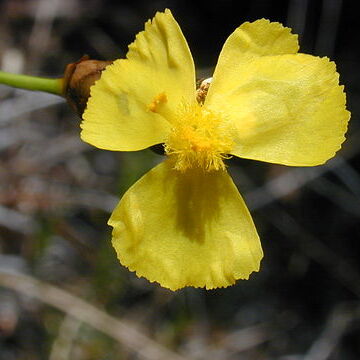Annual to perennial, scapose, rosulate, stems mostly short, cespitose, rarely rhizomatous. Leaves equitant, distichous, sheaths open, clasping, usually broad-based, with margins entire to ciliate or fimbriate, apically either narrowing gradually or abruptly to blade or there producing a ligule or auricle, blades mostly laterally compressed and 2-margined, mostly linear, less often thickened and ventrally sulcate to terete. Scapes single or few per shoot, arising from axillary buds, sheathed at base by a single, bladeless or bladed bract, terminating in a single spike (except in no. 3); spikes cone-like, chaffy-bracted, with 1 to many flowers; bracts in spiral or decussate, the lower 2-several empty, rarely forming a "leafy" involucre, commonly grading larger into the few to many flowering bracts, all or some with thicker central zone (dorsal area) of distinctly different texture and color or lacking dorsal area entirely. Sepals 3, generally hidden by subtending bract with 2 lateral, boat-shaped, free or connate, with variously margined keel and flanking a membranaceous inner (adaxial) sepal which enfolds the corolla in bud, detaching as the flower opens; petals 3, free (rarely connate), long-clawed, only the broad blades and claw tips exserted, these mostly yellow (in Africa some are blue); staminodes 3 (rarely lacking), mostly 2-branched with branches bearded; stamens mostly with flattened filaments and narrow, basifixed, introrse or laterally dehiscent anthers; ovary 1-or-3-locular, placentation marginal, parietal, basal, central or transitional, style tubular, slender, conduplicate, elongate, 3-branched just above petal claws, each branch terminating in a "U"-shaped stigma; stylar appendages absent. Capsules usually thinvalved; seeds (l-) few to many, mostly small and ovoid to fusiform, mostly longitudinally ribbed, opaque or translucent, embryo tiny, basal or lateral-basal.
Herbs, perennial, occasionally annual, rosulate. Stems simple, erect, sometimes caudiciform, short to branching, elongate. Leaves alternate, 2-ranked, equitant; blade mostly linear to filiform, flattened to nearly terete, margins smooth to variously papillate or scabrous. Inflorescences: scapes variously elongate; spike bracts imbricate, the proximal sterile, decussate, distal ones fertile, in spiral [decussate], bearing medially, usually subapically, a distinct and mostly differently textured and colored "dorsal area" or this indistinct or absent. Flowers solitary in bract axils; sepals 3, distinct, unequal, lateral (outer) sepals distinct [connate], chaffy, boat-shaped, chaffy, inner one membranous, capping corolla; keel papery, or scarious, variously winged, variously margined; petals 3, distinct [to connate], equal, strongly clawed; blade ephemeral, spreading, yellow to white; staminodes 3, distinct, strongly clawed, apically yoked, bearded with moniliform hairs (rarely reduced, beardless); stamens 3, epipetalous; anthers 2--4-locular; ovaries y thin-walled, placentation marginal to parietal [basal, free-central, axile]; styles elongate, tubular, 3-branched; stigmas 3, U-shaped or funnelform. Capsules 3-valved, usually thin, loculicidal. Seeds [1--]15--90 or more, mealy or translucent, ovoid to cylindric, 0.3--1(--4) mm, variously lined and cross-lined; endosperm starchy and proteinaceous; embryo basal-lateral, minute. x = 9.
Herbs perennial or rarely annual. Leaves equitant; leaf sheath sometimes with a short ligule; leaf blade linear to ensiform, smooth, papillose, rugose, or scaberulose. Peduncle scapelike, terete to compressed, sometimes winged or ribbed. Spikes few to many flowered; bracts brownish yellow to blackish brown, dull or shining, conchiform, rigid, abaxially minutely papillose toward apex when young, midvein conspicuous, margin scarious, entire, ciliate, fimbriate, or lacerate, apex emarginate, rounded, or acute. Sepals 3; lateral sepals with keel entire, dentate, or ciliate, wings membranous; median (anterior) sepal enclosing corolla or sometimes ± reduced or obsolete, thin and membranous, 1--3(--5)-veined. Petals 3, free; limb obovate; claw long and narrow. Stamens usually 3; filaments flattened; anthers basifixed, extrorse, dehiscing by vertical slits. Staminodes 3 or rarely absent, alternate with petals, often clawed, 2-cleft or 2-brachiate and branches with penicillate hairs. Ovary usually sessile, 1-or 3-loculed or imperfectly 3-loculed. Style filiform, apex 3-branched; stigmas usually U-shaped. Seeds obovoid to ellipsoid, longitudinally striate, apex usually apiculate.
Perennial, occasionally annual, tufted herbs of damp or wet situations. Leaves mostly basal, linear, terete, or lanceolate, sheathing at the base. Flowering scapes erect, simple, terminated by a solitary dense spike or head, and usually bearing 1 to several bladeless sheaths at the base. Flowering spikes or heads globose to elongate; bracts glumaceous, rather rigid or thin and papery, spirally imbricated, the lower usually sterile, the upper subtending the rather inconspicuous flowers. Flowers perfect, solitary and sessile in the axils of the bracts, yellow or blue, rarely white. Sepals 2-3, unequal. Petals 3, usually equal, obovate-spatulate, the basal claws free or united. Stamens 3, opposite the petals and adnate to claws; filaments usually short and flattened; anthers basifixed, 2-celled, dehiscent longi-tudinally. Staminodes (when present) 3, alternating with the petals, usually bifid at the tip, the branches usually tipped with brush-like tufts of moniliform hairs. Ovary 1-celled or imperfectly 3-celled; ovules numerous; style filiform, usually 3-cleft at the tip. Capsule loculicidal.
Annual or perennial herbs, often forming clumps; rhizomes, when present, short, horizontal or ascending. Leaves virtually all basal; ligule present or not. Inflorescence a condensed bracteate spike at the end of elongated peduncles which are often variously grooved or ridged; lower bracts of the spike sterile, occasionally elongated or reflexed. Flowers borne singly in the axils of the fertile bracts, short-lived; calyx of 3 unequal segments, the adaxial hooded and enclosing the flower-bud, the laterals asymmetric and often keeled, free from one another (sometimes fused basally in American species); corolla yellow (blue in at least one West African species). Stamens alternating with 3 usually bifurcate staminodes divided apically into many moniliform hairs. Ovary with parietal placentation (in East Africa). Fruit a loculicidal capsule.
Fls trimerous; anterior sep well developed, deciduous; pet distinct, with slender claw (hidden by the bract) and broad, yellow (white), toothed blade; staminodes present, bifid; placentas in most spp. (incl. ours) parietal, ± intruded distally; style-branches 3, alternate with the staminodes; seeds longitudinally lined. 250+, mainly warm reg.

